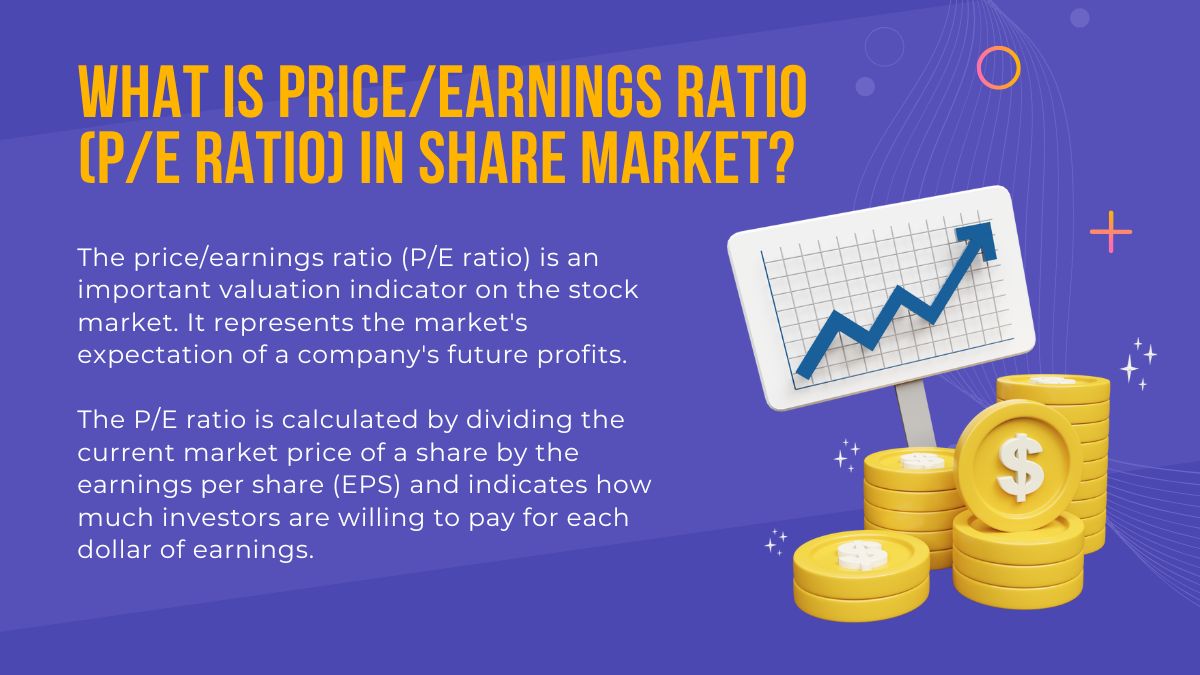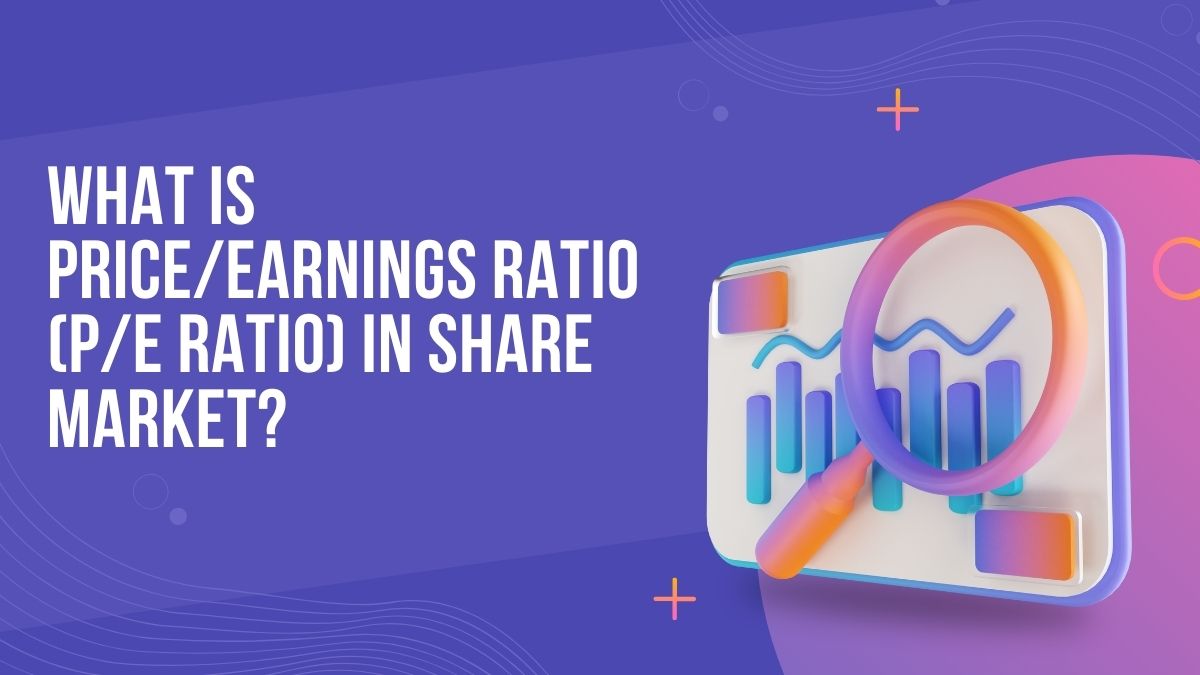The price/earnings ratio (P/E ratio) compares a company’s share price with its earnings and helps investors to assess whether a share is overvalued or undervalued. It is calculated as market price per share ÷ earnings per share (EPS) and reflects market expectations.
A high P/E ratio often signals growth potential, while a low P/E ratio can mean undervaluation or risk. There are trailing (past earnings) and leading (future estimates). Among other things, it is used for relative valuation and to identify investment opportunities.
However, it has limitations such as not taking into account debt, industry differences and growth potential. A negative P/E ratio indicates losses, often in start-ups or cyclical industries. Always combine the P/E ratio with other ratios to invest intelligently.
The price/earnings ratio (P/E ratio) compares the share price of a company with its profits. You can use this analysis to determine when the markets are overvaluing or undervaluing a company.
The P/E ratio is an effective tool for comparing the values of specific stocks or entire stock indices. In this post, we’ll look at the P/E ratio in detail, learn how to calculate it, and see how it can help you make updated investment decisions.
What is PE in Share Market?

The price/earnings ratio (P/E ratio) is an important valuation indicator on the stock market. It represents the market’s expectation of a company’s future profits. The P/E ratio is calculated by dividing the current market price of a share by the earnings per share (EPS) and indicates how much investors are willing to pay for each dollar of earnings.
A high P/E ratio may indicate that investors expect strong future growth, while a low P/E ratio may indicate an undervalued stock or potential financial difficulties. However, it’s important to note that P/E ratios can vary widely by industry and should be used in conjunction with other financial ratios for a comprehensive analysis.
What is PE in Share Market Formula?
Here is the formula for the price/earnings ratio (P/E ratio) on the stock market:
P/E ratio = market price per share / earnings per share (EPS)
Let us break down the components:
Market price per share: A share of the company is currently traded on the stock exchange at this price.
Earnings per share (EPS): This is the portion of a company’s net income that is attributable to each outstanding share of common stock.
Example:
Company ABC
Market price per share: ₹6,400
Earnings per share: ₹320
Price/Earnings (P/E) Ratio: ₹6,400 ÷ ₹320 = 20
This means investors are willing to pay ₹20 for every ₹1 of Company ABC’s current earnings.
What are the Main Types of PE?
There are two forms of P/E ratio: trailing and forward. The former is based on earnings per share from previous years, while the most commonly used or forward P/E ratio is calculated on the basis of future forecasts, generally provided by company management or equity analysts.
How to Use PE in Share Market?
One of the most common uses of the price/earnings ratio is to calculate the value of a share or index. The higher the ratio, the more expensive a share is in relation to its earnings. The lower the ratio, the cheaper the share. Below you will find out how you can use the price/earnings ratio (P/E ratio) to compare shares on the stock market:
1. Relative valuation
- Comparison with similar companies: The P/E ratio is the best tool for comparing companies in the same industry with similar market conditions. The term ‘high’ or ‘low’ P/E ratio is relative.
- Comparison with the industry average: To find out whether a company is over- or undervalued, compare its P/E ratio with the average P/E ratio of its competitors.
- Compare with the historical average: Track a company’s P/E ratio over time to determine if the current value is higher or lower than the historical average.
2. Analyze growth expectations
- High P/E ratio = high growth? Companies with high P/E ratios usually indicate that the market is predicting high future earnings growth. Analyze whether this expectation is necessary.
- Low P/E ratio = bad company? A low P/E ratio is not a sign that a company is undervalued. It may indicate slow growth opportunities or possible risks.
3. Identify potential investments
- Screening tool: Use the price/earnings ratio (P/E ratio) as a first filter to identify companies in a sector whose values are lower than those of their competitors.
- Starting point: Companies with lower P/E ratios deserve closer scrutiny, but they should not be the primary deciding factor.
What Are the Limitations of PE Ratio in Share Market?
Although the price/earnings ratio (P/E ratio) is a useful indicator, it has some limitations when analyzing shares:
- It does not take growth into account; the P/E ratio only looks at current profits and ignores a company’s future growth potential. A fast-growing company may require a higher P/E ratio, even if its current profits appear overvalued.
- Susceptible to accounting manipulation: Companies may use accounting techniques to temporarily inflate their earnings, resulting in a misleadingly low P/E ratio. It is important to go beyond the raw data.
- Industry differences: P/E ratios vary widely by industry. A high P/E ratio in a slow-growing industry may be considered expensive, but a similar P/E ratio in a fast-growing sector may be correct. Comparing companies in the same industry is crucial.
- No consideration of debt: The P/E ratio does not take into account a company’s debt load. A highly leveraged company may have artificially inflated earnings that make its P/E ratio look attractive, but the debt burden is a financial risk.
- Negative earnings: Companies with no profits or negative earnings make it difficult to calculate P/E ratios and require the use of other valuation methods.
- Snapshot in time: The P/E ratio is calculated for a specific point in time. Earnings and share prices fluctuate; therefore, a company’s P/E ratio can change quickly.
The P/E ratio is a fantastic starting point, but it is not the only factor that determines the value of a stock. Before making an investment decision, you should always do a full investigation and evaluate all the important variables.
Read more:
- What Is PB In Share Market? Your Guide To Value Investing
- Book Value Per Share: Understanding the Net Asset Value of a Company
What is a Good PE Ratio for Stocks?
When deciding on an investment based on the price/earnings ratio, investors sometimes ask themselves what makes it a good or safe ratio. However, it is important to know that the quality of a ratio varies depending on the current market conditions, the industry average P/E ratios, the type of company, etc.
Therefore, when comparing different P/E ratios, investors need to consider how other companies in the same industry with similar characteristics and stages of development are performing.
Let us understand a good P/E ratio with an example:
Comparing companies in the technology sector
Company A: P/E ratio of 40
Company B: P/E ratio of 25
At first glance, Company B seems more attractive due to its lower price/earnings ratio. However, consider the following:
Growth rates: Company A is a fast-growing software company with an annual earnings growth forecast of 30%. Company B is a reliable technology giant with an annual growth forecast of 10%.
Industry average: The average price/earnings ratio for the technology sector is 35.
In this case, Company A’s higher growth potential may justify its higher P/E ratio. While Company B has a lower P/E ratio, it is closer to the industry average and may not have the same upside potential.
What Does Negative PE Ratio Means?
A negative price/earnings ratio indicates that the company has negative earnings or is losing revenue. Even the best companies lose time. However, this does not mean that they have become a bad investment.
Below are two situations in which a company may have a negative P/E ratio, along with explanations:
Situation 1: Companies with recent losses
Company X: A newly founded technology company that is investing heavily in the research and development (R&D) of a new product. It has spent large sums of money while the product is still in development. These costs exceeded existing revenues, resulting in a net loss last year.
Negative P/E ratio: If the company’s share price is ₹1,600 and earnings per share (EPS) is -₹160, the P/E ratio is -10 (₹1,600 ÷ -₹160).
Situation 2: Company in a cyclical industry
Company Y: A car manufacturer experiences an economic slump. Consumer demand for cars drops dramatically, resulting in lower sales and the company announces a net loss for the year.
Negative P/E: Despite the temporary setback, the automaker’s shares could still trade at ₹2,400. However, an EPS of -₹80 would put the P/E ratio at -30 (₹2,400 ÷ -₹80).

